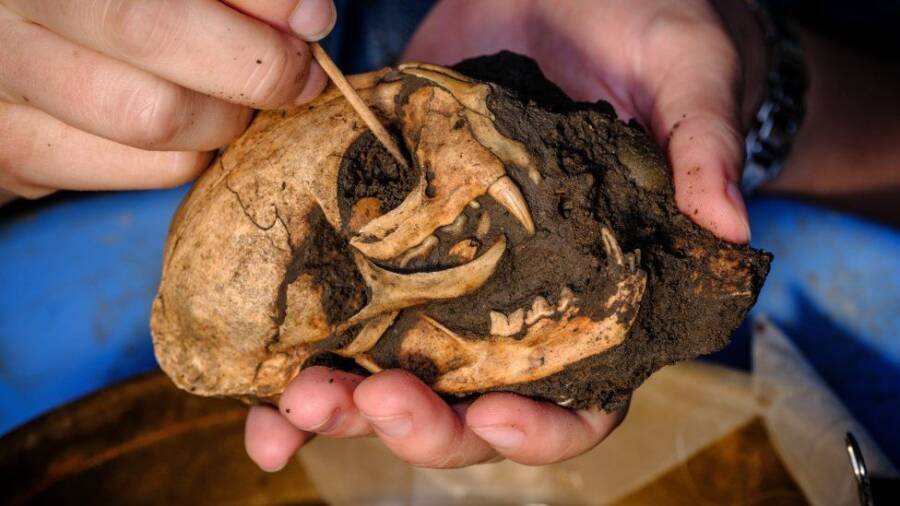Archeologists say that the amphitheater in Richborough, Kent, could hold up to 5,000 spectators who cheered on charging gladiators and roaring wild animals in epic fights.
Jim Holden / English HeritageArcheologists have been cognisant of the coliseum since 1849 , but the halt jail cell for gladiator is a new discovery .
Today , the Roman - epoch amphitheater in Richborough , Kent , blends into the landscape . But it was once the land site of vehement gladiatorial fighting , and archeologist with English Heritage have just hail across a holding electric cell , called a “ carcer , ” where gladiators wait to fight .
“ The discoveries we ’ve made during the excavation at Richborough are startling and exciting , and dramatically transform our sympathy of the bodily structure of the amphitheater and the nature of adjacent settlement in the town,”said Paul Pattison , English Heritage senior property historian .

Jim Holden/English HeritageArcheologists have been aware of the amphitheater since 1849, but the holding cell for gladiators is a new discovery.
researcher have known about the amphitheater since 1849 , when prissy archaeologists find it . But the most recent examination of the site uncover a cell within the arena . With wall more than six groundwork tall , the cell once held “ those who entered the bowl to contact their fate , whether wild beast , criminals , or gladiators,”according to English Heritage .
Though much is unknown about the amphitheater , its chalk and greensward mental synthesis suggests it was ramp up around the 1st C , when Romans first invaded Britain . At its peak , it would have been an impressive visual modality : Archeologists find surprising traces of “ vivid ” ruddy and gamy paints on its interior walls .
“ The grounds of painted ornamentation we have found on the arena rampart , a singular find so far in amphitheatre in Britain , is remarkable , and a wonderful reminder that aspects of papist culture abroad were also a feature of life in romish Britain , ” explained Tony Wilmott , senior archaeologist at Historic England .

Jim Holden/English HeritageThe Richborough archaeological site near where the amphitheater is located.
Jim Holden / English HeritageThe Richborough archaeological site near where the amphitheater is located .
Wilmott noted that the amphitheater could probably hold about 5,000 spectators , who — just like in Rome — descended to watch bloody gladiator fighting . Sometimes , these fights pitted prizefighter against each other . Other time , in especially tearing battles calledvenationes , captive or gladiators fought against wild animals like lions and bear .
The bare existence of the amphitheater speaks to Richborough ’s crucial plaza in the Roman Empire . Thencalled Rutupiae or Portus Ritupis , the liquidation in all probability existed from the 1st to the quaternary century , or as long as the Romans occupied Britain . And it was said to be renowned throughout the empire for the quality of its oysters .

English HeritageThe skull of what appeared to be a carefully buried pet cat.
“ As Richborough is coastal , it would have bring home the bacon a connective between what was at the clock time call Britannia and the rest of the Roman Empire , ” excuse Pattison , notice that Richborough would have been unique and divers .
“ Because of that , all sorts of Romans who come from all turning point of the Empire would have passed through and lived in the settlement . ”
Alongside the carcer , archeologists found several artefact that help paint a picture show of life in Roman Catholic - era Richborough . They found coins , pottery , the bone of butchered creature , and jewellery . Remarkably , archeologists also discover the carefully buried skeleton of what appear to be a pet Arabian tea .
English HeritageThe skull of what appeared to be a cautiously buried deary hombre .
Dubbed “ Maxipus ” by archaeologist — after Russell Crowe ’s case inThe prizefighter — the CT was find buried just outside the amphitheater walls . It may have had nothing to do with the amphitheater itself but “ appeared purposefully buried on the edge of a ditch , ” consort to English Heritage .
In addition , the most recent excavation also uncovered the flummox remnants of two “ seriously burnt ” and “ bright orange ” orthogonal area just outside the amphitheater .
“ It is not yet known what map these buildings fulfilled , ” noted English Heritage , “ but it is possible they stood on each side of an entrance leading up to the seating bank of the arena . ”
The fire that destroyed the structures , the organisation said , “ must have been dramatic . ”
Today , Richborough ’s amphitheatre subsist only as a circular field covered in pasture . But , as the creation of the withstand cubicle suggest , this part of the world once rang with thousands of screaming spectators , roaring animals , and rouse gladiators .
After read about the prizefighter cellular telephone find in the Richborough amphitheatre , watch about theRoman Leo the Lion handlefound in Britain , which indicate that prisoners were raven by lions . Or , discover thetrue story of the popish emperor moth Commodus fromGladiator .